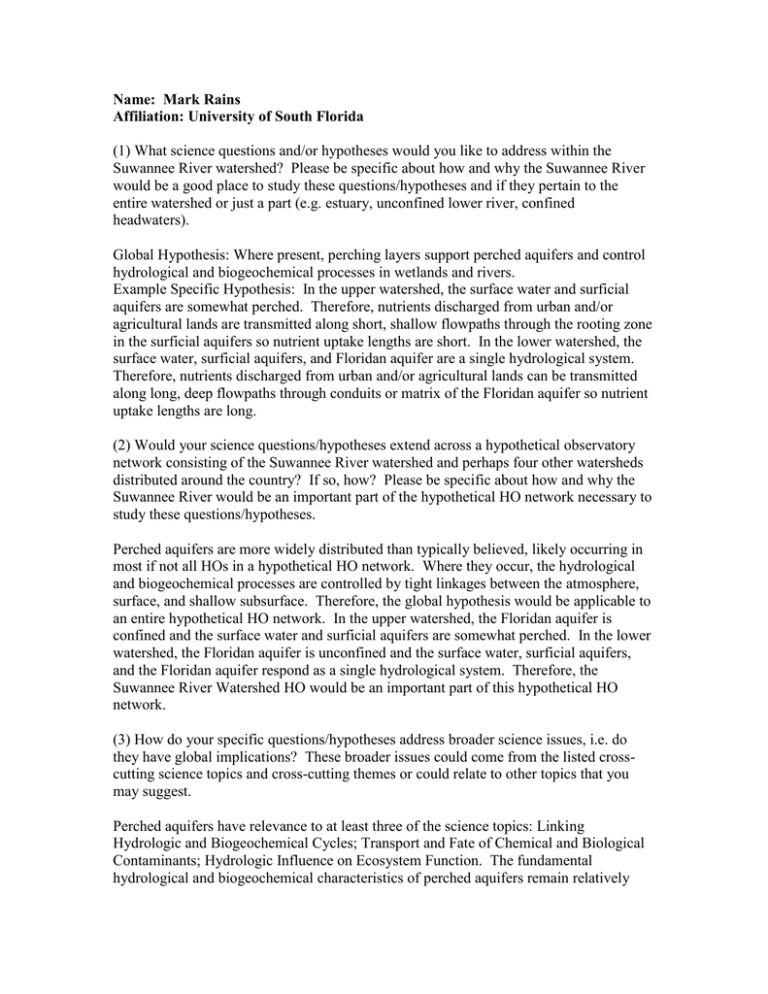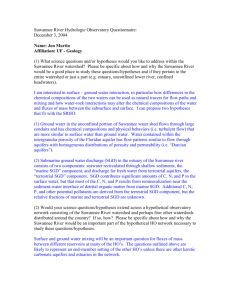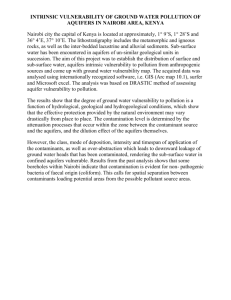Rains
advertisement

Name: Mark Rains Affiliation: University of South Florida (1) What science questions and/or hypotheses would you like to address within the Suwannee River watershed? Please be specific about how and why the Suwannee River would be a good place to study these questions/hypotheses and if they pertain to the entire watershed or just a part (e.g. estuary, unconfined lower river, confined headwaters). Global Hypothesis: Where present, perching layers support perched aquifers and control hydrological and biogeochemical processes in wetlands and rivers. Example Specific Hypothesis: In the upper watershed, the surface water and surficial aquifers are somewhat perched. Therefore, nutrients discharged from urban and/or agricultural lands are transmitted along short, shallow flowpaths through the rooting zone in the surficial aquifers so nutrient uptake lengths are short. In the lower watershed, the surface water, surficial aquifers, and Floridan aquifer are a single hydrological system. Therefore, nutrients discharged from urban and/or agricultural lands can be transmitted along long, deep flowpaths through conduits or matrix of the Floridan aquifer so nutrient uptake lengths are long. (2) Would your science questions/hypotheses extend across a hypothetical observatory network consisting of the Suwannee River watershed and perhaps four other watersheds distributed around the country? If so, how? Please be specific about how and why the Suwannee River would be an important part of the hypothetical HO network necessary to study these questions/hypotheses. Perched aquifers are more widely distributed than typically believed, likely occurring in most if not all HOs in a hypothetical HO network. Where they occur, the hydrological and biogeochemical processes are controlled by tight linkages between the atmosphere, surface, and shallow subsurface. Therefore, the global hypothesis would be applicable to an entire hypothetical HO network. In the upper watershed, the Floridan aquifer is confined and the surface water and surficial aquifers are somewhat perched. In the lower watershed, the Floridan aquifer is unconfined and the surface water, surficial aquifers, and the Floridan aquifer respond as a single hydrological system. Therefore, the Suwannee River Watershed HO would be an important part of this hypothetical HO network. (3) How do your specific questions/hypotheses address broader science issues, i.e. do they have global implications? These broader issues could come from the listed crosscutting science topics and cross-cutting themes or could relate to other topics that you may suggest. Perched aquifers have relevance to at least three of the science topics: Linking Hydrologic and Biogeochemical Cycles; Transport and Fate of Chemical and Biological Contaminants; Hydrologic Influence on Ecosystem Function. The fundamental hydrological and biogeochemical characteristics of perched aquifers remain relatively unexplored. The management of perched aquifers should rest on a scientific foundation that provides a general understanding of the conditions necessary to maintain perched aquifers capable of supporting the physical and biological functions of dependent wetland ecosystems. This scientific foundation, though within reach of current technologies and methods, appears to be virtually nonexistent because hydrogeologists have largely pursued analyses of regional aquifers that can be exploited for water supply purposes rather than perched aquifers that typically are too local and/or shallow to be exploited for any appreciable water supply purposes. The recognition that perched aquifers play important roles in maintaining some wetland ecosystem functions provides a renewed impetus to study and better understand shallow perched groundwater systems. (4) What kind of data would be required to address your questions/hypotheses? Be as specific as possible about the scale, frequency, and resolution of the sampling needed. Describe the data as either core data collected by the observatory and immediately disseminated to the community or individual investigator data collected by a principle investigator with extramural funding but using facility infrastructure. Core Data Data Aerial photographs Surficial geology maps Soils maps Evapotranspiration Precipitation volume Precipitation geochemical characteristics Regional surface water head/flux Regional groundwater head/flux Regional surface water and groundwater geochemical characteristics Frequency Decadally One time One time Daily Daily Monthly (volume weighted means) Daily Monthly Monthly Investigator Data Data Shallow cores Surface water and perched groundwater head/flux Surface water and groundwater geochemical characteristics Frequency One time Daily Weekly, daily or more frequently during select storms (5) What resources (time, money, personnel) are needed to collect data to address the science questions and can any data be leveraged for the observatory? This question will be important when we start to develop a budget for the observatory. Much of the core data could be leveraged from existing data sources. However, much of the data has gaps that would need to be filled, and much of the data is not currently collected at all. By far the largest expense would be evapotranspiration stations throughout the HO. Each station would cost tens of thousands of dollars to construct, and would need to be regularly maintained and repaired. (6) What type of Education/Outreach activities do you envision for the results of your science questions or are you interested in developing Education/Outreach activities that stand alone from specific science questions? I am interested in developing education/outreach activities that stand alone from the science questions. Mathematics educators are concluding that new approaches are needed to prepare future alumni to deal with the barrage of data that awaits them. Among the new approaches is teaching mathematics in context, and so mathematics educators are seeking partners with interesting context. I am interested, therefore, in collaborating with the National Numeracy Network in linking mathematics educators with our context-based data set and developing modular, web-based mathematics exercises. (7) If you do not have specific science-driven topics, but wish to be involved in the observatory, please explain what your interests are and how you might interact with the observatory.




